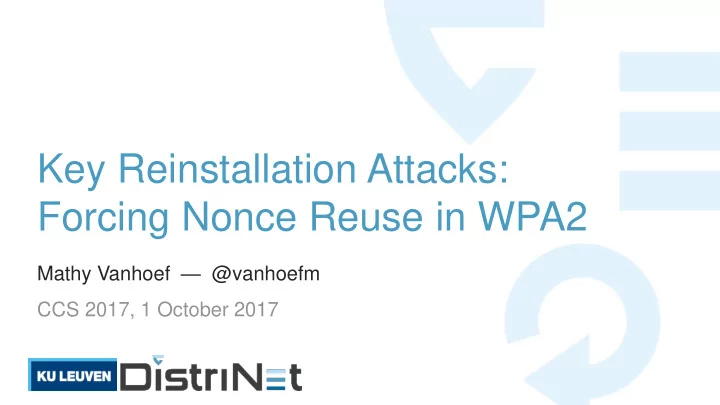

Key Reinstallation Attacks: Forcing Nonce Reuse in WPA2 Mathy Vanhoef — @vanhoefm CCS 2017, 1 October 2017
Overview Key reinstalls in 4-way handshake Misconceptions Practical impact Lessons learned 2
Overview Key reinstalls in 4-way handshake Misconceptions Practical impact Lessons learned 3
The 4-way handshake Used to connect to any protected Wi-Fi network Two main purposes: › Mutual authentication › Negotiate fresh PTK: pairwise temporal key Appeared to be secure: › No attacks in over a decade (apart from password guessing) › Proven that negotiated key (PTK) is secret 1 › And encryption protocol proven secure 7 4
4-way handshake (simplified) 5
4-way handshake (simplified) PTK = Combine(shared secret, ANonce, SNonce) 6
4-way handshake (simplified) Attack isn’t about ANonce or SNonce reuse PTK = Combine(shared secret, ANonce, SNonce) 7
4-way handshake (simplified) 8
4-way handshake (simplified) 9
4-way handshake (simplified) PTK is installed 10
4-way handshake (simplified) 11
Frame encryption (simplified) Nonce Plaintext data (packet number) Packet key PTK Mix (session key) Nonce Nonce reuse implies keystream reuse (in all WPA2 ciphers) 12
4-way handshake (simplified) Installing PTK initializes nonce to zero 13
Reinstallation Attack Channel 1 Channel 6 14
Reinstallation Attack 15
Reinstallation Attack 16
Reinstallation Attack Block Msg4 17
Reinstallation Attack 18
Reinstallation Attack In practice Msg4 is sent encrypted 19
Reinstallation Attack Key reinstallation! nonce is reset 20
Reinstallation Attack Same nonce is used! 21
Reinstallation Attack keystream Decrypted! 22
Overview Key reinstalls in 4-way handshake Misconceptions Practical impact Lessons learned 23
General impact Transmit nonce reset Decrypt frames sent by victim Receive replay counter reset Replay frames towards victim 24
Cipher suite specific AES-CCMP: No practical frame forging attacks WPA-TKIP: › Recover Message Integrity Check key from plaintext 4,5 › Forge/inject frames sent by the device under attack GCMP (WiGig): › Recover GHASH authentication key from nonce reuse 6 › Forge/inject frames in both directions 25
Handshake specific Group key handshake: › Client is attacked, but only AP sends real broadcast frames › Can only replay broadcast frames to client 4-way handshake: › Client is attacked replay/decrypt/forge FT handshake (fast roaming = 802.11r): › Access Point is attacked replay/decrypt/forge › No MitM required, can keep causing nonce resets 26
Implementation specific Windows and iOS: 4-way handshake not affected › Cannot decrypt unicast traffic (nor replay/decrypt) › But group key handshake is affected (replay broadcast) wpa_supplicant 2.4+ › Client used on Linux and Android 6.0+ › On retransmitted msg3 will install all-zero key 27
Overview Key reinstalls in 4-way handshake Misconceptions Practical impact Lessons learned 28
Misconceptions I Updating only the client or AP is sufficient › Both vulnerable clients & vulnerable APs must apply patches Need to be close to network and victim › Can use special antenna from afar No useful data is transmitted after handshake › Trigger new handshakes during TCP connection 29
Misconceptions II Obtaining channel-based MitM is hard › Nope, can use channel switch announcements Attack complexity is hard › Script only needs to be written once … › … and some are already doing this! 30
Overview Key reinstalls in 4-way handshake Misconceptions Practical impact Lessons learned 31
Limitations of formal proofs › 4-way handshake proven secure › Encryption protocol proven secure The combination was not proven secure! 32
Model vs. implementation Abstract model ≠ real code › Must assure code matches specification The wpa_supplicant 2.6 case › Complex state machine & turned out to still be vulnerable › Need formal verification of implementations 33
On a related note… Workshop on: Security Protocol Implementations: Development and Analysis (SPIDA) Co-located with EuroS&P 2018 “ focuses on improving development & analysis of security protocols implementations” 34
Thank you! Questions? krackattacks.com
References 1. C. He, M. Sundararajan, A. Datta, A. Derek, and J. Mitchell. A Modular Correctness Proof of IEEE 802.11i and TLS. In CCS, 2005. 2. S. Antakis, M. van Cuijk, and J. Stemmer. Wardriving - Building A Yagi Pringles Antenna. 2008. 3. M. Parkinson. Designer Cantenna. 2012. Retrieved 23 October 2017 from https://www.mattparkinson.eu/designer-cantenna/ 4. E. and M. Beck. Practical attacks against WEP and WPA. In WiSec, 2009. 5. M. Vanhoef and F. Piessens. Practical verification of WPA-TKIP vulnerabilities. In ASIA CCS, 2013. 6. A. Joux. Authentication failures in NIST version of GCM. 2016. 7. J. Jonsson. On the security of CTR+ CBC-MAC. In SAC, 2002. 36
Countermeasures Problem: many clients won’t get updates Solution: AP can prevent (most) attacks on clients! › Don’t retransmit message 3/4 › Don’t retransmit group message 1/2 However: › Impact on reliability unclear › Clients still vulnerable when connected to unmodified APs 37
Handshake specific Group key handshake: › Client is attacked replay broadcast frames to client › Because client never sends real broadcast frames! Unicast 38
Recommend
More recommend